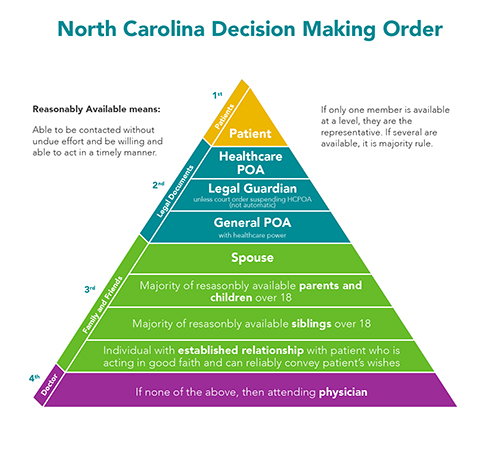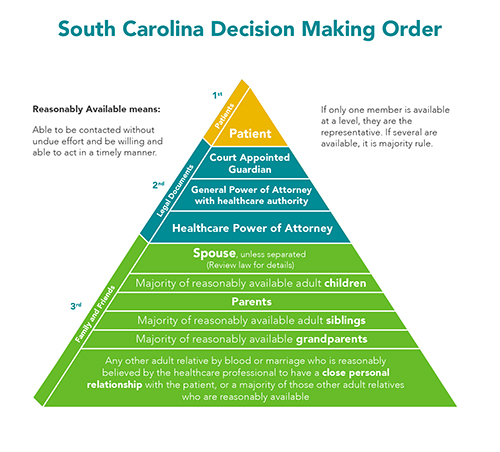Your Advance Directive: Step 3 – Write It Down
Once you have selected your healthcare agent, decided what type of treatment you want, and shared your decisions with your agent and loved ones, it’s time to write down those decisions by completing an advance directive.
In North Carolina, an advance directive has three parts: a healthcare power of attorney, a living will and advance instruction for mental health treatment. In South Carolina, an advance directive has two parts: a healthcare power of attorney and a living will. You don’t have to complete all parts of the form. If you’d prefer, you can choose to complete just one or two parts.
Completing Your Healthcare Power of Attorney
When completing your healthcare power of attorney form, you should complete all sections of the form.
If you would like to limit your agent’s power or have any other special instructions, write those in the special instructions section of the North Carolina form. Be as specific as possible. If you do not have any special instructions, write a line through that section to show that you are intentionally leaving it blank. To limit your agent’s power on the South Carolina form, use the limitations section of the form.
If you do not complete the healthcare power of attorney form and you are unable to make your own decisions, state law requires doctors to talk with the following people, in the order listed below for North Carolina and South Carolina:
Click image for larger version.
If none of the people above are available, the law allows your doctor to make decisions for you as long as another doctor agrees with those decisions.
Completing Your Living Will
A living will is only used if you are unable to make decisions for yourself. When completing this form, you will be asked to choose whether you want life-prolonging measures in different circumstances. Life-prolonging measures are medical treatments that would postpone death, including CPR, ventilators, tube feeding (artificial nutrition or hydration) and similar forms of treatment. Below you will find a brief definition of these treatments.
- CPR (cardiopulmonary resuscitation) is an attempt to restart your heart by repeatedly pressing on your chest while sending air into your lungs. Electric shocks known as defibrillation might also be used.
- Ventilators are machines that help you breathe by forcing air into your lungs through a tube.
- Tube feeding can provide your body with liquid nutrients if you are unable to eat or drink. A feeding tube will first be placed in the nose and down to the stomach. If long-term tube feeding is needed, a tube can be surgically inserted into the stomach.
These are very important decisions to make and it may take time to decide the right treatment choices for you. Take your time and ask your doctor for help. Below are some common questions that many people ask during this decision-making process.
How do the doctors know I won’t recover?
Doctors do several tests to know the severity of a patient’s condition and how much of a chance there is for recovery.
Can I have treatment for a short period of time?
Yes. If you would like to do this, you or your healthcare agent would need to discuss this with your doctor.
Does having a living will mean doctors won’t resuscitate me?
No. A living will is a guide for your healthcare team and agent to follow when making choices about your future treatment.
How is a living will different from a DNR (do not resuscitate) order?
A living will is a guide for your healthcare team and agent to follow when making choices about your future treatment. A DNR is a medical order your healthcare team must follow as soon as it is signed.
What is a MOST or POST form?
MOST stands for medical orders for scope of treatment. POST stands for physician order for scope of treatment. These are doctors’ orders that details the types of treatment you would like to receive. A MOST or POST form is typically used with patients who have advanced life-limiting illnesses who are not expected to live longer than a year. A MOST or POST form must be completed by you or your healthcare agent or family, plus your doctor. It is effective as soon as it is signed by both parties.
When completing your healthcare power of attorney and living will it is important to read the instructions thoroughly and take your time. Do not sign the North Carolina form unless you have two witnesses and a notary present to notarize your forms. To see the witness and notary requirements for the South Carolina forms, visit the Lieutenant Governor’s Office on Aging website.
Changing Your Advance Directive
You can always make changes to or cancel your advance directive. Once you have signed and completed your forms, it is highly recommended that you review and update them any time you face one of the following events:
- Decade: As you grow older, your choices and values may change. It is a good habit to review your advance directive every 10 years and update your wishes as needed.
- Death of a loved one: When you lose a loved one, you may find that seeing what they went through at the end of their life may change your own personal values. This is a good time to review the decisions you made.
- Divorce: If you are going through a divorce or separation, and your spouse is named in your advance directive as your healthcare agent, you may wish to update your forms.
- Diagnosis: If you find out you have a medical condition, the effects of the illness could change your mind about the types of treatment you would want. It is important to understand your condition, the long-term effects, and what type of decisions you may need to make. It is important to discuss these things with your healthcare provider.
- Decline: If your health is getting worse, this is a good time to make sure your healthcare agent knows about your wishes and to update your advance directive. This is also a good time to talk with your healthcare provider about your advance directive and MOST or POST form. A North Carolina MOST (Medical Order for Scope of Treatment) form lists specific treatment choices to be followed in the event of a medical emergency. You can read more about the MOST form and how it differs from an advance directive on the North Carolina Medical Society website. In South Carolina, this is called a POST (Physician Order for Scope of Treatment) form. You can read more about the state’s program on the South Carolina POST website.
If you want to change your advance directive, you should destroy any copies of your old forms and replace them with the new forms. It is also a good idea to communicate your changes to your healthcare provider, healthcare agent and loved ones.
The only person who can change your living will and healthcare power of attorney is you. The only exception to that rule is if you gave that power to your healthcare agent when completing your healthcare power of attorney form.
Share Your Decisions
Once you’ve completed your advance directive, you’ll need to tell your doctors and loved ones. Your advance directive can only be followed if you let others know about the choices you’ve made. Take a look at next steps.



